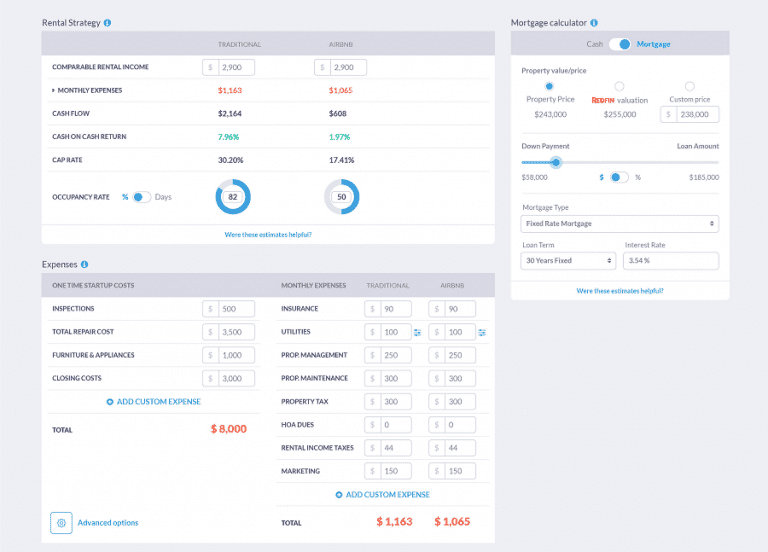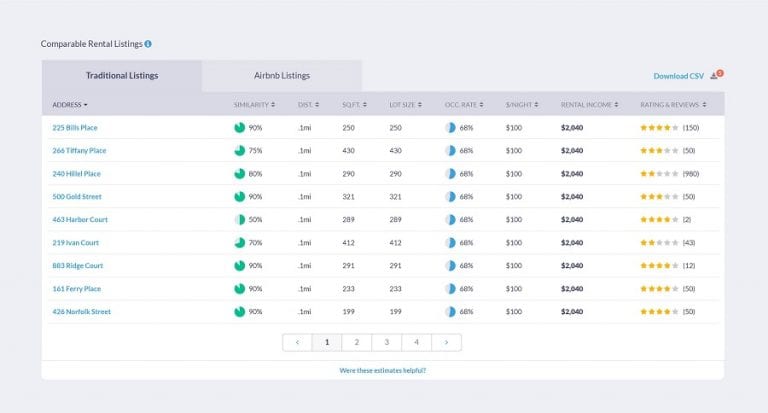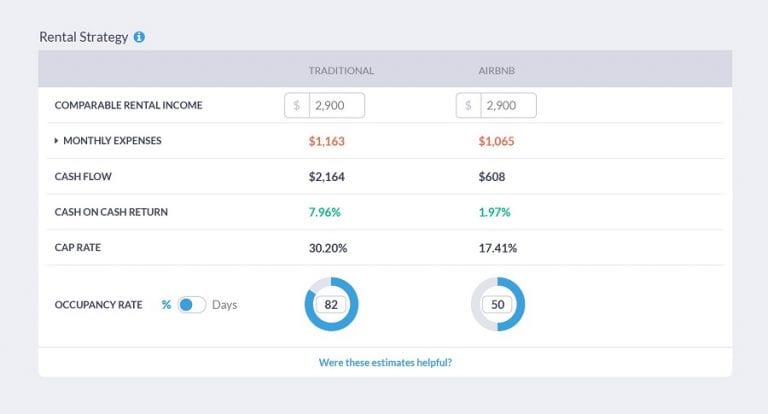Positive cash flow means the total amount of cash moving into a business is higher than the total amount of cash moving out during a given time period. For property investors, this means your total cash income from a rental property is higher than your total cash expenses.
If you’re interested in buying rental property and making positive cash flow in real estate, keep reading to learn:
- Why positive cash flow is important in real estate
- How to calculate positive cash flow (with an example)
- How to find positive cash flow investments
- How to make your property a positive cash flow rental
Why Is Positive Cash Flow So Important to Investors?
It’s been proven that buying and owning real estate investments is one of the best ways to make money in the US housing market. But not every property for sale that you find will turn out to be profitable as a rental. First-time real estate investors often ask: What’s the secret to making profits when investing in rental properties? This “secret”, however, is actually an obvious answer: It’s all about generating positive cash flow. So if you want to make sure you’re buying a good rental property, you need to calculate its potential cash flow first. Here’s why:
1. It Means You’re Making Money
Calculating real estate cash flow is an effective way to see how much money you’ve made from an income property during a certain time period. As a property investor, your goal is to see positive cash flow as it indicates that the net operating income you receive from the rental property covers all your expenses and leaves you with a profit margin. This also means that the income property makes enough money to easily pay off the money you initially invested. If instead, you have zero cash flow, it means all of the property’s income goes to the costs of running the investment property (i.e. there is no cash remaining for you). As for negative cash flow, it means the property’s operating expenses cost more than what it makes (i.e. you’re losing money) – no real estate investor wants that!
2. It’s Used to Estimate Your ROI
After reading the above positive cash flow definition, you realize that it’s one of the numbers in real estate that gives you a better understanding of your investment property’s financial performance and potential. Cash flow is also one of two ways for making money in real estate, the other being appreciation. However, experts always advise investing for positive cash flow as it provides you with a source of income that’ll keep you afloat. In fact, it’s the essence of a good rate of return on real estate investment (ROI). This is because cash flow strongly influences the two most important metrics of ROI: the cap rate and cash on cash return. When you own a positive cash flow rental property, you’ll feel less stressed and more confident as a real estate investor.
3. It Narrows Down Your Property Search
If there’s a number of homes for sale that interest you for real estate investing and you’re unsure of which one to go after, knowing how to calculate positive cash flow helps. Using cash flow to estimate ROI along with cap rate and cash on cash return allows you to better compare real estate investment opportunities. When you learn which properties are cash flow positive and which are not, narrowing your options and eliminating bad deals becomes easier. Then, you can run a thorough investment property analysis on the few remaining options to reach a final decision on which one is worth investing in. This is how successful income property investors make smart investment decisions.
Mashvisor helps investors find positive cash flow homes for sale in the US housing market in a matter of minutes! Give it a try now.
4. It Makes Lenders More Likely to Trust You
Knowing that you’ve got yourself real estate positive cash flow properties gives you an advantage if you’re planning to use a mortgage to finance the purchase. If you want to get a loan, one of the first things that asset-based lenders look at is how much income the property will generate. And to decide if a property justifies a certain loan amount, lenders look at its debt service coverage ratio (DSCR). This is calculated by dividing the property’s net operating income by its total debt service obligations. Lenders want to see a DSCR well above 1.0 as it means the rental property generates enough cash flow to cover its debt obligations and other expenses. So, by showing that you’re buying positive cash flow investment properties, you’ll have higher chances of getting approved for a loan.
How to Calculate Positive Cash Flow
- Calculate Net Operating Income
NOI tells you the income left over after paying all your every-day rental expenses (not including financing). These are called operating expenses, and they include things like vacancy reserves, management costs, property taxes, insurance, maintenance, etc. To calculate net operating income, simply subtract all these costs from the gross rental income.
- Deduct Capital Expenses
CapEx for short, are real-life costs of items that wear out over time and must be replaced to keep the real estate investment in good shape. They include large expenses like roofs, heat-and-air systems, driveways, and other structural items. The number that you’ll get from deducting CapEx from NOI is known as cash flow from operation.
- Calculate & Deduct Financing Costs
If you’re financing the real estate deal with a loan, your cash flow will be used to make regular payments to your lender. So, the next step is to calculate the monthly payment on the loan (including both principal and interest) and deduct it from the cash flow from operation. The number you get from this is known as cash flow after financing.
- Deduct Taxable Rental Income
After paying your operating expenses, CapEx, and your lender, you’ve still got to pay income taxes before you can figure out what you get to keep. The last step, then, is to find how much of your rental income is taxable and deduct that from cash flow after financing. This final number is known as cash flow after tax and it’s the profit you’ll get to keep from your real estate investment.
For more details, read: Learn How to Calculate Rental Property Cash Flow
Example of a Positive Cash Flow Investment
Let’s take an example of how to calculate positive cash flow in real estate. Say you’ve found a 3-unit multi-family home for sale and want to see if it makes financial sense to buy it as an investment property. The purchase price for this property is $300,000 and you’re going to put a 20% down payment ($60,000). The mortgage is a 30-year loan at 6% with a principal/interest payment of $360 a month. Say that you’ll rent out each unit for $500 per month for a gross rental income of $1,500. Let’s also assume that operating expenses sum up to $600 – this means that your NOI is ($1,500 – $600 = $900).
The second step is to deduct capital expenses from the NOI. After running your numbers, you find that CapEx for this real estate investment property is $80 per month. Hence, your cash flow from operations is ($900 – $80 = $820). Moving on to deducting monthly financing costs, your cash flow after financing is ($820 – $360 = $460). Now you have to pay your income tax bill and deduct it from this number. How much your rental income is taxed depends on your location. For this example, let’s say you have to pay $240 for income tax per year ($20 per month). Thus, the final monthly cash flow after tax is ($460 – $20 = $440). This is positive cash flow and the profit you’ll get to keep from owning this rental property.
Tip: An easier way to run all these numbers is to use Mashvisor’s Rental Property Calculator. It uses real estate data and predictive analytics to calculate not only cash flow, but also the cap rate, cash on cash return, and more! To learn more about it, click here.
How to Find Positive Cash Flow Rental Properties
So now you understand why it’s important to own an income property that is cash flow positive and how to calculate the numbers to make sure you’ve got a good real estate deal. But how can you find positive cash flow rental properties in which to invest? To answer this question, we’ve laid down what you need to do step-by-step:
Step 1: Find a Good Rental Market
Location determines each and every aspect of a rental property, including its cash flow. So the first step is to pick a profitable real estate market for buying rental property rather than sticking to what’s convenient for you. Key features of an ideal location include a strong economy, a good job market, and a high demand for rental properties. Ask yourself: Are home prices rising? How is the school system? What are the demographics? Answers to such questions give you a better idea of your potential profit margins. For example, college towns are typically considered some of the best places to invest in real estate because there is a high/stable demand for rentals. In turn, this means fewer vacancies and higher rents – the perfect combination for positive cash flow.
Step 2: Narrow Down Your Options
After identifying a good location to invest in real estate, it’s time to start your investment property search. In order to find positive cash flow properties, there are a few things to keep in mind during this step. First off is your budget. Based on your savings and income, decide on the maximum price you can afford to pay for an income property without risking a default on your mortgage payments. Then, make sure to search for properties within your budget. Also, you need to find out what property type best suits your area. If you’re in a school district, for example, single-family homes would be the best choice. But if you’re in a tourist destination, buying a vacation home makes more sense.
Another important thing to do to narrow down your options of rental properties for sale is to search for comparables (or rental comps). In other words, you need to do a comparative market analysis. Doing so allows you to make sure you’re paying a reasonable price for your property. Moreover, by comparing how similar rentals are performing in terms of revenue and vacancies, you’ll get an idea of how profitable your investment will be and how much real estate positive cash flow you’ll end up with.
Step 3: Analyze the Rental Property
The final and most important step is to run a rental property analysis. This includes running all the numbers associated with the real estate deal to make sure it’s worth the investment. This includes not only calculating positive cash flow but other metrics like the cap rate and cash on cash return as well. If this sounds like a daunting task, don’t worry – these 3 steps can actually be done on a single platform: Mashvisor!
This real estate investor website first lets you do an investment property search in any city, neighborhood, and zip-code in the US housing market. To quickly find the best homes for sale in your market of choice, we created the Property Finder which shows you top-performing properties that fit with your personal criteria (including your budget, property type, rental strategy, and more). Once you’ve found one that interests you for real estate investing, Mashvisor provides you with a complete purchase analysis which includes all the data you need to know about the property like its rental income, expenses, cash flow, cap rate, cash on cash return, and occupancy rate.

Moreover, we also provide real estate investors with a list of rental comps ready for you to do a CMA and not waste time looking for them on your own. This list comes with reliable, pre-calculated data so you can compare your property to actual rentals in the area in a matter of minutes.

To start looking for and analyzing positive cash flow investments in your city/neighborhood of choice, sign up to Mashvisor!
How to Make Any Property Cash Flow Positive
If you, for some reason, ended up buying an income property that is not cash flow positive, here are some tips on how you can still turn it into a profitable real estate investment:
1. Set the Right Rental Rate
From the positive cash flow definition and the steps to calculating it, you should know by now that your rental income is the core of how much profits you’ll earn. Once you buy and own a rental property, you have to decide how much rent to charge tenants. To ensure positive cash flow, the rental rate must be enough to cover your mortgage payments and other monthly recurring expenses. However, it should not be too high – this will only push potential tenants away and leave you with a vacant rental.
So, aim to set your rent according to the average rental rate for similar rental properties in the area and think of ways to boost it. Renovations are a good example. Homes improvement – whether big or small – on your property can increase its value. Your property will have a higher demand and this allows you to charge a higher rent than other landlords in the area without facing the risk of losing tenants or positive cash flow.
2. Add Additional Sources of Income
When investing in rental properties, your main source of income might be from the rent collected, but it doesn’t have to be the only one. Smart real estate investors get creative and think of what they can add to their investment that’ll positively impact their returns. Some examples include providing and charging for services that other landlords don’t offer like cleaning fees and laundry fees. You can also maximize income by charging application fees, late fees, adding storage and parking, and allowing pets.
3. Cut Down Operation Expenses
The next part of the cash flow formula is your expenses. As a property investor, you have to pay attention to the total cash leaving your rental business. Keeping your expenses to a minimum increases your chance of positive cash flow. Major expenses include, but are not limited to, property tax, management, repairs, insurance, etc. For example, if you can manage the rental property yourself instead of hiring a professional manager, this can save more of the rental income which will otherwise go to management fees. In addition, you should always put money aside for contingencies and repairs. If you run into an unexpected vacancy, for example, where will you get rental income to pay your mortgage and other fees? Always be prepared!
4. Pay Attention to Financing Costs
As you can see from our example above, financing costs have a huge effect on cash flow. So if you want to finance your investment property with a loan, make sure that the interest rate and monthly payments make sense to you in the long run. In general, it’s best to avoid taking out a loan with a high interest rate. A higher interest rate will only increase your monthly expenses and, if your income does not cover them, you’ll risk defaulting on the loan and getting the property foreclosed. Hence, the lower the interest rate on your investment property, the less costly it is to own it. Accordingly, lower financing costs mean you are more likely to profit from positive cash flow in real estate.
5. Choose the Right Rental Strategy
You can buy a house and rent it out either as a long-term traditional rental or a short-term vacation rental. The rental strategy you choose plays a role in your rental yield and, thus, cash flow. Some investors pick their strategy based on their liking. However, the right thing to do is to base your decision on location and real estate data.
For example, if your housing market is in a school district or seeing job growth, demand could be higher for traditional rentals. And perhaps your area doesn’t see more than a handful of tourists every year. In this case, renting out your property on Airbnb may not be a smart choice as the property will end up being vacant and not generating income. On the other hand, if you’re investing in a tourist destination and data proves that the Airbnb occupancy rate here is high, then the property will make positive cash flow as a vacation rental.
You can see which rental strategy is best with Mashvisor’s Rental Property Calculator. It provides data comparing how the property will perform as a traditional and Airbnb rental.

Want to give our real estate investment tool a try? Click here!
Key Takeaways
Generating positive cash flow is the most important way to maintain a profitable real estate investment. In this complete guide, we’ve covered everything property investors need to know about this metric. Make sure to keep it in mind and do your due diligence when deciding whether or not to move forward with homes for sale as investment properties. If you have any questions regarding cash flow in real estate, feel free to leave them in the comments below!
Learn more about Mashvisor’s tool and how we’ll help you make faster and smarter real estate investment decisions.